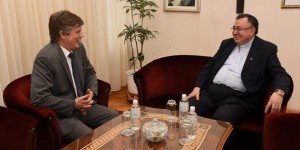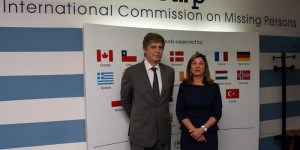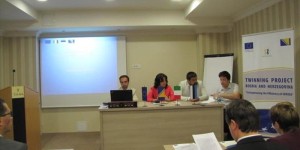EU Commissioner for Regional Policy, Johannes Hahn will be joining high-level politicians and representatives from the 14 member countries of Europe’s Danube “Macro-Region” for their 3rd Annual Forum in Vienna on 26-27 June. Jointly organised by the European Commission, the Republic of Austria and the City of Vienna, the Forum will be opened by Austrian Foreign Affairs Minister, Sebastian Kurz and Mayor and Governor of the capital region, Michael Häupl.
Ministers, civil society and business representatives from the 14 Danube countries will discuss and decide how best to drive the region forward – under the slogan “We grow together – Together we grow”. A special focus will be on competitiveness, social inclusion and good governance, following the European Commission’s recent report calling for stronger political leadership of EU Macro-Regions. ‘Greening the River” and renewing its fleet will also be high on the agenda.
Following recommendations in the governance report, the Danube countries’ Foreign Affairs Ministers will be meeting alongside the Forum to propose concrete arrangements for a better managed leadership of the Strategy. Minister Peter Friedrich from the Baden-Württemberg region – which is set to host the next annual gathering, is expected to report back to the Forum.
Speaking ahead of the Forum, European Commissioner for Regional Policy Johannes Hahn commented: “The EU Danube Strategy clearly shows the value of working together on issues such as energy security, navigation, improved water quality and enhanced technology transfer. The Strategy develops initiatives and projects based on the objectives of the Europe 2020 strategy. To make sure the potential of this new approach is fully utilised, we need more commitment, involvement and ownership. We all need to play our part in moving from words to action – and ensure that the Danube Region continues to be a model for other macro-regional initiatives.”
The Forum also comes as Partnership Agreements for the European Structural and Investment Funds for 2014-2020 are being adopted. The Member States involved must ensure that the Danube Strategy is firmly embedded in these investment plans, and that the future programmes translate Danube Region priorities into concrete goals.
A novelty at this year’s Forum is the ‘Danube Cosmos’ – a series of activities (including workshops, coaching zones, stands, speakers’ corners etc.) presenting initiatives and projects, on a wide range of topics covering all the priorities of the Strategy. This will bring together partners to share ideas and best practice.
Several meetings will have a special focus on cleaner navigation, including the “Policy meets industry” event. This will bring together high-level business representatives and political decision-makers in order to formulate concrete measures to improve the current infrastructure and navigability situation along the Danube.
Background
The EU’s Danube Strategy was launched in April 2011. It involves 9 EU countries (Germany, Austria, Hungary, Czech Republic, Slovakia, Slovenia, Bulgaria, Romania and Croatia) and 5 non-EU countries (Serbia, Bosnia and Herzegovina, Montenegro, Ukraine and Moldova). Designed to coordinate EU policies across the Region, it is based on the idea that common challenges – whether environmental, economic or security related – are best tackled collectively. By involving EU neighbouring countries at an equal level, the Danube Strategy also brings the Western Balkans, Moldova and the regions of the Ukraine closer to the Union.
The recent Commission report on governance of the EU’s Macro-Regional Strategies (for the Baltic Sea Region and for the Danube Region) found that the Strategies are bringing concrete results on the ground. However, obstacles do remain with regard to impact, results and sustainability. Particular improvement is needed concerning political leadership and decision making, as well as a clearer organisation of work and definition of roles and responsibilities.
Example of projects:
The Danube Region Gas Market Model is designed to measure the transnational spill-over effects of the gas infrastructure projects planned in the Region on gas prices. The model identified the six most decisive gas-related investments of the Danube Region and has resulted in the Danube countries now agreeing on policy recommendations for future projects.
Innovative vessels research project: supporting further shipping technology developments to modernise the Danube fleet, with more competitive and environmentally-friendlier approaches, e.g. better ship body design for new vessels and technological innovations that can improve the performance of existing ones. This contributes to the overall goal to increase sustainable cargo transport on the river by 20 % by 2020, compared to 2010.
The Danube Sturgeon task force (DSTF) is working to secure viable populations of Sturgeon in the Danube River. The species is valuable key indicator of water quality and ecosystem health, but has been on the brink of extinction due to the overexploitation, disruption of spawning migration and loss of habitats. The DSTF is taking urgent measures to stop their decline.
The European Commission’s Joint Research Centre now provides scientific support to the Danube Strategy, in cooperation with key scientific partners from the Region. A high level conference takes place on 24-25 June in Vienna, in conjunction with the Annual Forum. Results on their research activities will be presented there. Four thematic scientific clusters are being launched to foster scientific cooperation and to streamline research activities.
More information:
European Union Strategy for the Danube Region
3rd Annual Forum of the EU Strategy for the Danube Region, Vienna
Report on the Governance of Macro-Regional Strategies (May 2014)
Evaluation Report concerning the added value of macro-regional strategies
Twitter: @EU_Regional @JHahnEU #EUSDR #Danube



